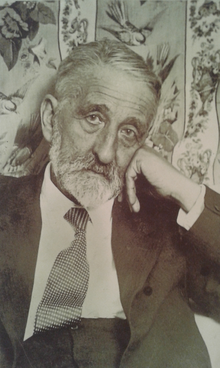Manuel Bartolomé Cossío
[1] He was director of the Museo Pedagógico Nacional and president of the Misiones Pedagógicas, becoming "the most eminent figure in Spanish pedagogy in the period 1882 to 1935", two years after his death.
[citation needed] He spent part of his childhood in Aranda de Duero, Sepúlveda, and Arévalo (places that he will always evoke throughout his life).
[citation needed] After passing through the Institute of Ávila, on September 8, 1868, he entered as a boarding student in the school of secular priests of El Escorial, receiving a rigid religious education; although the one who most impresses him is Father Mountain and his "philosophical-historical ideas".
That year, on November 6, his mother, Natalia Cossío, died, and the young institutionalist suddenly disappeared from Madrid, creating a misunderstanding that would take time to clear up.
He was impressed by the Italian literature class of the poet Giosuè Carducci (although like many others he was annoyed to see him always "dirty and disheveled"), and he obtained a certificate in the School of Pedagogy and Anthropology of that University.
Back in Spain, he was substitute professor in the chair of History of Fine Arts, in the academic year 1881-1882 at the Higher Diplomatic School of Madrid; him continuing his classes at the Institution.
In 1886 Cossío traveled commissioned by the Government to visit the main schools in France, Belgium, Holland and Great Britain; He was accompanied by Giner de los Ríos and a group of students from the ILE .
In 1904 he received the appointments of full professor of Superior Pedagogy of the Doctorate of Philosophy and Letters of the University of Madrid and delegate of Spain in the International Congress of Education of San Luis (United States).
In 1908 El Greco was published, a biography and artistic study which, in addition to providing new data and ordering its catalogue, led to a discovery of the figure and personality of the Greek-Spanish painter and its revaluation in the 20th century based on a different interpretation and innovative.
On August 4, 1917, Natalia, Cossío's eldest daughter, entered into a civil marriage with another active institutionist, Alberto Jiménez Fraud, who ran the Residencia de Estudiantes in Madrid.
In 1926, during the celebration of the fiftieth anniversary of the Institución Libre de Enseñanza, Cossío, who had been appointed Minister of Public Instruction five years earlier, wrote (without signing it) the pedagogical program of the Institution.
One of his last satisfactions was the creation in Valencia of the " Cossío School ", 89 directed by José Navarro Alcácer and installed on Avenida 14 de Abril, a and whose classrooms were open from 1930 until the end of the war .
However, at that time (1931), the old teacher saw the old dream come true that Giner and he himself had matured over almost half a century: the start-up of the Pedagogical Missions, of whose patronage the Government would appoint him president.
[citation needed]Of the incomprehensible task carried out by Bartolomé Cossío, we should list, as a guide, some of the reforms —of different magnitude and repercussion— that became a reality thanks to his efforts: "...from my disciples I have learned... more than from my teachers."
[citation needed]The psychological and human profile that Cossío drew with his own intellectual and vital work, is completed with innumerable portraits of his personality made by many of those who knew and treated him.
As samples can be collected two of those portraits of very different literary style, the poetic one of Juan Ramón Jiménez, and the emotional memory of one of his students, the politician Julián Besteiro .
"Yes, here he is already with his eyes, the windmill hands in the sky, his gaze fresh -I remember a twilight seascape from the North like Cossío; a cloudy seascape, nobly colorful, with a ship stranded on the coast, exchanged water and sky, in whose revolution he calmly watched over a star-.It stands, like a bent lily, with a new water -Cossío has a lot of tender vegetable and rich mineral; few men have seemed to me so landscape-.




